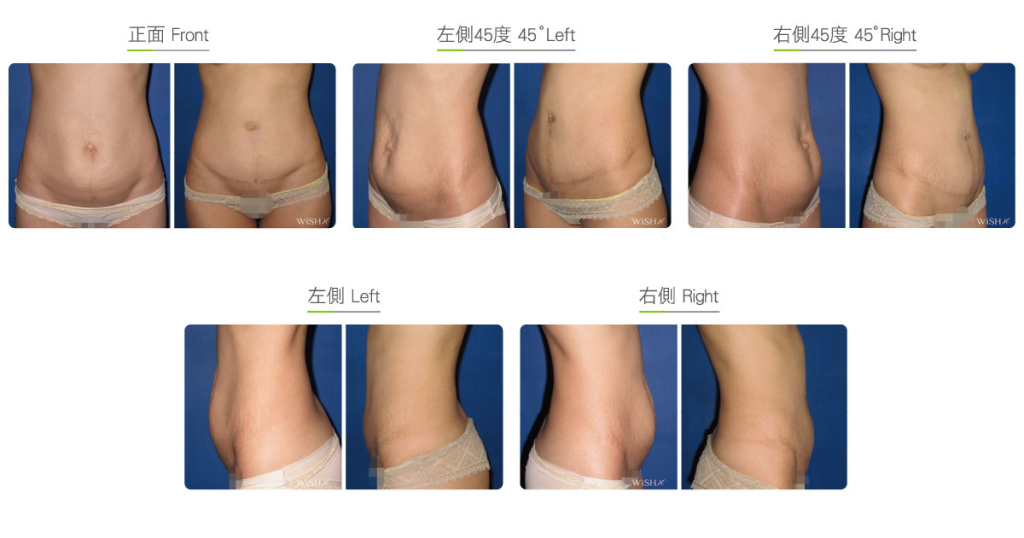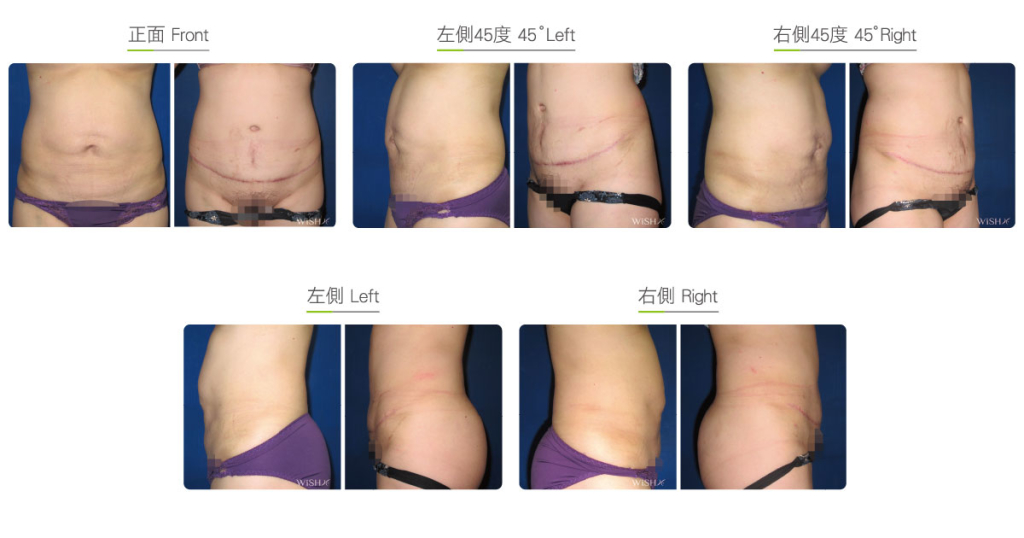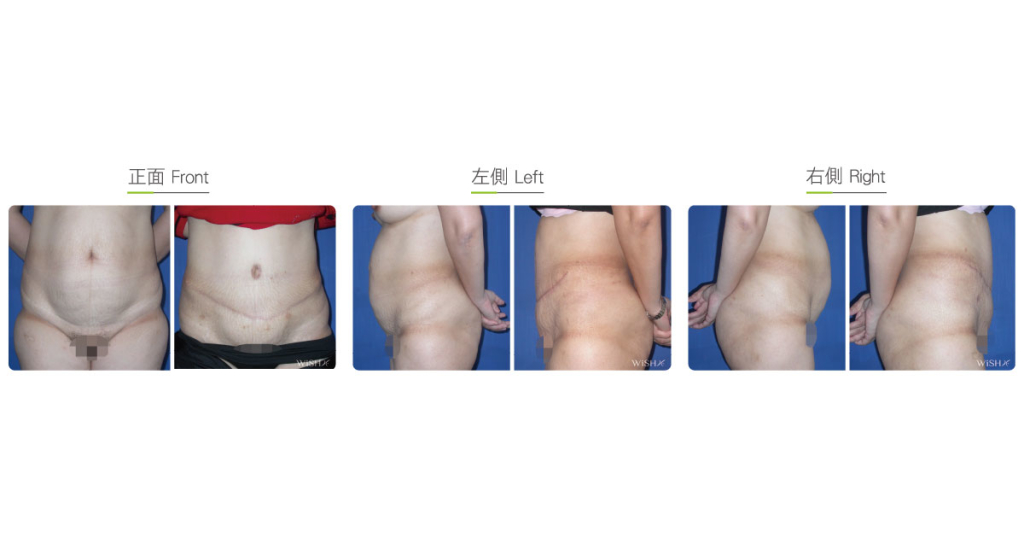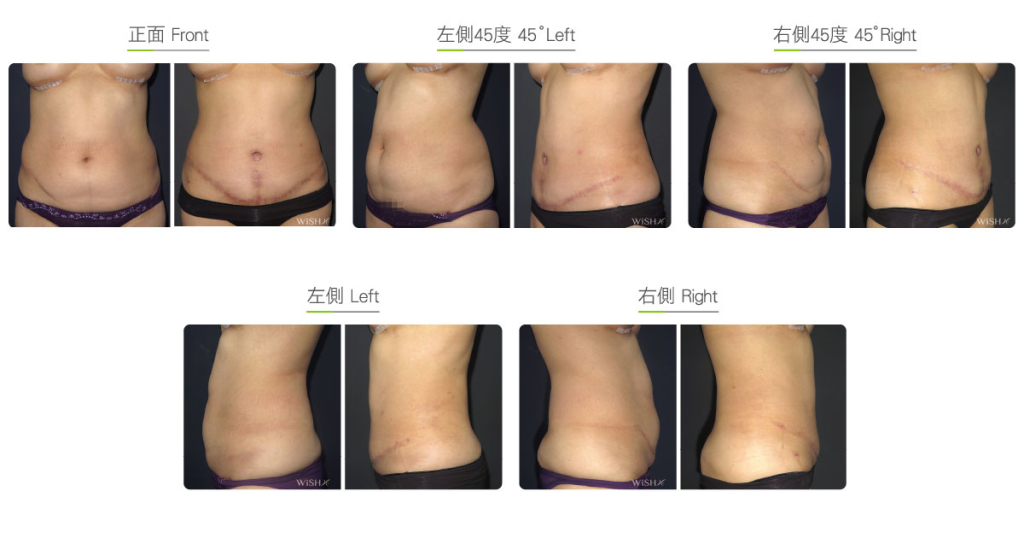Complete Abdominoplasty
This is also called full tummy tuck. The surgical scope extends from the superior pubic margin to the costal inferior margin; the navel should be reconstructed (umbilicoplasty), and liposuction of the bilateral waists should be also performed at the same time. This amounts to slimming with the most comprehensive and complete results. First starting in the surgery, a 25–30-cm incision is made at lower abdominal skin creases or a prior cesarean section line, and the skin is widely dissected from the abdominal muscles via the incision to the uppermost costal inferior margin. Attention should be paid to preserve the blood circulation and integrity of the original navel. Then, the rectus abdominis muscle at both sides of the midline is stitched by strong non-absorbable sutures to restore stretched muscles incurred by gestation or obesity to the midline and make the abdominal wall flat, which not only helps sculpt the waist curvature but also effectively addresses the disturbances of abdominal or stomach prominence induced by eating or drinking. After muscles are stitched, the originally loose or droopy skin and fat tissues are stretched downward to the abdominal incision and the excess cellulite is removed. Finally, the preserved navel is fixated to the new position, and the entire wound is stitched.
The surgical scope is relatively deep and extensive, and postoperative recovery is long. In particular, because it is within postoperative 2–3 days, patients present with pain or limited activities due to the stitching of abdominal muscles, and they need to rest in bed. Moreover, to prevent postoperative hematoma or the congestion of the skin flap, patients should retain a drainage tube for the collection of residual blood for approximately 5–7 days. Patients should also avoid exertion abdominal work or strenuous activities for 1 month to prevent complications such as the premature loosening of abdominal muscle sutures or wound dehiscence. To shorten the recovery period and alleviate pain, Dr. Chuang advises the use of fibrin glue to facilitate rapid wound adhesion and postoperative pain control, which accelerates postoperative recovery and lower adverse surgical reactions.
Surgical conditions
Duration
- Type of anesthesia: General anesthesia
- Type of incision: A 25–30-cm incision at the lower abdomen (superior to the pubes) An incision around the navel
- Recovery: 5–7 days
- Removal of stitches: 10–14 days
- Length of hospitalization: 1 day
General instructions
No food and water on the day of surgery
- Avoid any abdominal force application for 2 weeks postoperatively.
- Avoid abdominal exertion for 1 month postoperatively.
- Avoid strenuous abdominal activities for 3 months postoperatively.
- Wear a compression garment for 3 months postoperatively to promote the recovery and tightening of the abdomen.
- Take care of the scar consistently for 6 months postoperatively.
Ideal candidates
- Patients with severe abdominal laxity or obvious pregnancy marks due to pregnancy
- Those with fat deposits or abdominal droopiness due to excess obesity
- Those likely to have obvious abdominal bulging (abdominal prominence or stomach prominence) due to drinking water or eating food
- Those with a navel deformity or unesthetic appearance due to abdominal looseness
- Those with abdominal unevenness or laxity due to prior liposuction or other laparotomies
Possible complications
- Subcutaneous seroma
- Hematoma
- Poor wound healing
- Scar proliferation
- Navel deformity
- Decreased skin sensitivity (temporary)
Surgical advantages
-
It resolves abdominal obesity and skin laxity at one time.
-
It concurrently improves the navel and lower abdominal pregnancy marks.
-
It reconstructs the S-shaped waist curvature prior to pregnancy.
-
It restores the flat abdomen and presents distinct and prolonged slimming results
-
It simultaneously reconstructs the navel.
Surgical drawbacks
-
The surgery is relatively extensive and the duration is long, so postoperative recovery is slow.
-
Postoperative pain is relatively obvious in around the first 2–3 days
-
The patient needs to hospitalize in the clinic for 1 day for postoperative observation
-
A drainage tube is inserted for 5–7 days, so postoperative activity is relatively limited.
-
The incision is long and may induce scar proliferation.
-
Pregnancy in the future may undermine surgical results and durability.
Possible procedures in conjunction
-
Abdomen liposuction
-
Saddle area liposuction
Before & after
Complete Abdominoplasty + Belly Button Surgery (Umbilicoplasty)





